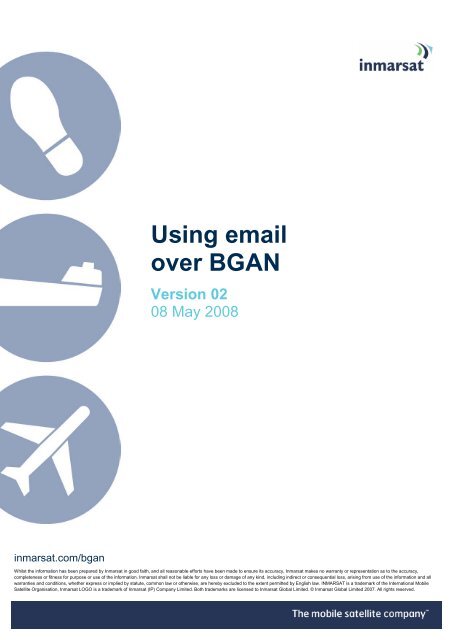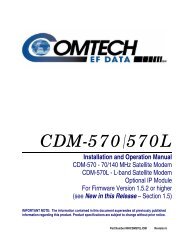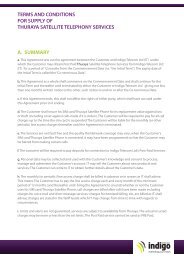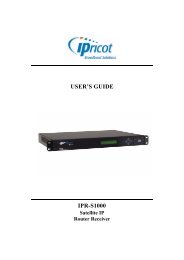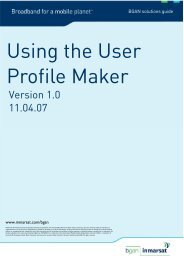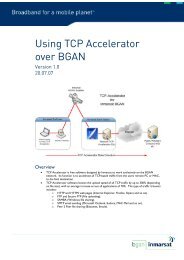You also want an ePaper? Increase the reach of your titles
YUMPU automatically turns print PDFs into web optimized ePapers that Google loves.
<strong>Using</strong> <strong>email</strong><br />
<strong>over</strong> <strong>BGAN</strong><br />
Version 02<br />
08 May 2008<br />
inmarsat.com/bgan<br />
Whilst the information has been prepared by <strong>Inmarsat</strong> in good faith, and all reasonable efforts have been made to ensure its accuracy, <strong>Inmarsat</strong> makes no warranty or representation as to the accuracy,<br />
completeness or fitness for purpose or use of the information. <strong>Inmarsat</strong> shall not be liable for any loss or damage of any kind, including indirect or consequential loss, arising from use of the information and all<br />
warranties and conditions, whether express or implied by statute, common law or otherwise, are hereby excluded to the extent permitted by English law. INMARSAT is a trademark of the International Mobile<br />
Satellite Organisation, <strong>Inmarsat</strong> LOGO is a trademark of <strong>Inmarsat</strong> (IP) Company Limited. Both trademarks are licensed to <strong>Inmarsat</strong> Global Limited. © <strong>Inmarsat</strong> Global Limited 2007. All rights reserved.
Contents<br />
1 Introduction 1<br />
1.1 About this guide 1<br />
1.2 Other sources of information 1<br />
2 Introduction to <strong>email</strong> 1<br />
2.1 SMTP 2<br />
2.2 POP3 3<br />
2.3 IMAP4 3<br />
2.4 HTTP (WebMail) 3<br />
2.5 Microsoft Exchange 3<br />
2.6 Lotus Notes 4<br />
3 Improving <strong>email</strong> performance 4<br />
3.1 General principles 4<br />
3.2 Compression 4<br />
3.3 <strong>Using</strong> specialized software solutions 5<br />
4 Optimizing <strong>email</strong> clients 5<br />
4.1 Optimizing Outlook Express 6<br />
4.2 Optimising Eudora 5.1 7<br />
4.3 Optimizing Mozilla Thunderbird 7<br />
5 <strong>BGAN</strong> testing and analysis 8<br />
5.1 Factors affecting performance 8
1 Introduction<br />
1.1 About this guide<br />
This document describes the use of <strong>email</strong> applications <strong>over</strong> the <strong>BGAN</strong> network, and includes<br />
advice on how to improve network performance and optimize <strong>email</strong> clients.<br />
It is intended for first time end-users, Distribution Partners, Service Providers and anyone who<br />
wants to use a <strong>BGAN</strong> terminal to connect to the <strong>BGAN</strong> network and use network services. A<br />
previous knowledge of <strong>email</strong> client software is required. A previous knowledge of satellite<br />
communications is useful, but not essential.<br />
The sections include:<br />
• Introduction to <strong>email</strong> – in particular, the common <strong>email</strong> protocols.<br />
• Improving <strong>email</strong> performance – explains how to optimize <strong>email</strong> on satellite networks, and list<br />
some of the specialized solutions available.<br />
• Optimizing <strong>email</strong> clients – gives hints and tips on how to maximize the performance of some of<br />
the most commonly used clients, including Outlook Express, Eudora and Mozilla Thunderbird.<br />
• <strong>BGAN</strong> testing and analysis – gives the results of extensive testing of <strong>email</strong> protocols carried out<br />
<strong>over</strong> the <strong>BGAN</strong> network, and lists some of the factors than can affect network performance,<br />
including latency, jitter and packet size.<br />
• Email scenarios – shows a typical remote office scenario.<br />
1.2 Other sources of information<br />
• This is one of a series of PDF documents that make up the <strong>BGAN</strong> Solutions Guide. The<br />
Solutions Guide is designed to help you make the most of your <strong>BGAN</strong> terminal. Other<br />
documents in the series are available for download from www.inmarsat.com/bgan. Click on<br />
Support, then click on User guides.<br />
This Web site also gives further information on the <strong>BGAN</strong> service, including Industry solutions.<br />
• Refer to “<strong>Using</strong> <strong>BGAN</strong> LaunchPad” for details on using <strong>BGAN</strong> LaunchPad. This document is<br />
available for download from www.inmarsat.com/bgan<br />
• Refer to the documentation supplied with your <strong>email</strong> client software for details on changing<br />
configuration and settings.<br />
2 Introduction to <strong>email</strong><br />
The <strong>BGAN</strong> service enables remote offices or users to maintain <strong>email</strong> communications with<br />
company headquarters or business partners anywhere in the world. You can connect the <strong>BGAN</strong><br />
terminal to the Internet, and use the <strong>email</strong> services provided by your Internet Service Provider<br />
(ISP), including text-based <strong>email</strong>, and the transfer of data attachments, such as Word documents,<br />
Excel spreadsheets or PowerPoint presentations.<br />
Email is usually accessed using one of the following four protocols, all supported on the <strong>BGAN</strong><br />
network:<br />
• SMTP<br />
• POP3<br />
• IMAP4<br />
• HTTP<br />
<strong>Using</strong> <strong>email</strong> <strong>over</strong> <strong>BGAN</strong> Page 1
There are also a number of proprietary protocols commonly in use, including:<br />
• MSRPC (Microsoft Remote Procedure Call) for Microsoft Exchange Server.<br />
• NotesRPC (Remote Procedure Call) for Lotus Notes.<br />
These protocols use the following ports:<br />
Protocol Source Port Destination port<br />
SMTP Dynamic 25 (TCP)<br />
POP3 Dynamic 110 (TCP)<br />
IMAP4 Dynamic 143 (TCP)<br />
HTTP Dynamic 80<br />
Microsoft Exchange (MSRPC) Dynamic Dynamic<br />
Lotus Notes (Notes RPC) Dynamic 1352<br />
SMTP, POP3 and IMAP4 are used by all Internet <strong>email</strong> clients, for example Outlook Express, (but<br />
not Exchange Server), Mozilla Thunderbird and Eudora. See section 4.0 ”Optimizing <strong>email</strong> clients”,<br />
for details on how to maximize the performance of these clients.<br />
2.1 SMTP<br />
Each of these protocols is described below.<br />
SMTP (Simple Mail Transfer Protocol) is used to upload (send) <strong>email</strong>s from a client to the ISP’s<br />
mail server for delivery. If you are using Enhanced SMTP (ESMTP), it also defines the basic<br />
mechanism for transferring mail between one server and another.<br />
SMTP operates as follows:<br />
a. The client sends information to the server.<br />
b. The server responds with an acceptance or rejection message.<br />
If the server is using Enhanced SMTP (ESMTP) the sending server (or client) can authenticate with<br />
the receiving server, as described below:<br />
a. The sending server sends the originator address and recipient addresses to the receiving server.<br />
b. If the receiving server agrees to transfer the message from the originator to the named<br />
recipient(s), the sending server is asked to send the message data.<br />
The message data consists of the message header and message body. The message body can be<br />
either plain text, or can be more complex and contain, for example, HTML attachments. More<br />
complex messages are encoded into a MIME (Multipurpose Internet Mail Extensions) stream.<br />
Note MIME encoding can increase the size of a message by up to 50%<br />
Tip<br />
Some ISPs do not support SMTP from other networks. A symptom of this is the ability to<br />
receive <strong>email</strong> but not send <strong>email</strong>. A “server not found” or “timeout” error may be reported.<br />
One possible solution to this is to subscribe to a dedicated <strong>email</strong> service from your<br />
Distribution Partner (DP). You can also use the default SMTP server provided by <strong>Inmarsat</strong><br />
which is:<br />
SMTP.bgan.inmarsat.com<br />
<strong>Using</strong> <strong>email</strong> <strong>over</strong> <strong>BGAN</strong> Page 2
2.2 POP3<br />
POP3 (Post Office Protocol v3) is the most common <strong>email</strong> download method used by ISPs. It<br />
defines how an <strong>email</strong> client interacts with a server in order to download messages, determines how<br />
many messages are waiting and defines a method to retrieve the messages.<br />
POP3 is a simple protocol, and usually downloads all messages in your Inbox as text streams;<br />
normally, it does not allow you to specify which messages to download. However, some clients<br />
enable you to configure your <strong>email</strong> application so that only the first few kilobytes of each message<br />
are downloaded. In this way, you can choose to download complete messages only when required.<br />
Most ISPs encourage the use of POP3 clients because customer mailboxes are cleared on each<br />
connection, and so do not take up resources at the ISP.<br />
2.3 IMAP4<br />
IMAP4 (Interim Mail Access Protocol v4) offers greater functionality than POP3, and is available on<br />
some ISP servers. Instead of simply downloading all <strong>email</strong>, IMAP4 gives you the option of using the<br />
client to manage the <strong>email</strong>s held on a server; for example, you can maintain a structure of folders<br />
on the server, and you can also move headers between folders without downloading the messages.<br />
In addition, you can view message headers, and select which messages you want to download<br />
immediately, select which can be deleted, and select which can be saved until you are back in the<br />
office.<br />
In addition, if the mailbox is susceptible to junk mail and Spam mail, these messages can be<br />
deleted without downloading.<br />
A typical IMAP session involves the following steps on the client:<br />
a. Authenticate with the server.<br />
b. Check the capabilities of the server.<br />
c. Check the number of messages in the Inbox<br />
d. Request a list of headers for all messages in the Inbox. This list populates the client’s Inbox<br />
view.<br />
e. When you request a message, the client sends a request to the server to download that<br />
message only.<br />
Note<br />
IMAP4 can be configured to download all messages, if required.<br />
2.4 HTTP (WebMail)<br />
HTTP (Hypertext Transport Protocol) is commonly available as an alternative to POP3 services. It<br />
allows you to access your mailbox through a web browser, not an <strong>email</strong> client. In addition, you can<br />
view your Inbox before downloading messages, and so you can choose the messages you want to<br />
download.<br />
2.5 Microsoft Exchange<br />
Microsoft Outlook clients can use the Microsoft-Remote Procedure Call (MS-RPC) to communicate<br />
with the Microsoft Exchange Server. If you use standard Exchange mode, MS-RPC must be used.<br />
In all other cases, Outlook clients can use the SMTP, POP3 and IMAP4 protocols.<br />
Note<br />
The use of the term RPC does not imply a similarity with any other RPC protocol. MS-RPC<br />
is a proprietary protocol, and has no public specification.<br />
Note the following when using MS-RPC:<br />
• MS-RPC is best used <strong>over</strong> a LAN, as the connection between the client and server requires a<br />
significant amount of bandwidth. It is not well suited to <strong>BGAN</strong>.<br />
<strong>Using</strong> <strong>email</strong> <strong>over</strong> <strong>BGAN</strong> Page 3
• MS-RPC has a number of security flaws, and is best used <strong>over</strong> a VPN, where possible.<br />
• Server, client and firewall must be correctly configured, as the clients and servers allocate<br />
dynamic ports for connections.<br />
• Microsoft Outlook should be used in remote mode, using an OST file (early versions) or cached<br />
mode (later versions).<br />
TIP<br />
To use Microsoft Outlook <strong>over</strong> <strong>BGAN</strong>:<br />
• Use a VPN connection, wherever possible.<br />
• Ensure that your client is set to cached mode.<br />
• Consider using SMTP/IMAP when away from the office.<br />
By default, Microsoft Outlook clients are optimized for use <strong>over</strong> a high speed, low latency network.<br />
You may need to change the configuration of your client, depending on the connection type used.<br />
2.6 Lotus Notes<br />
Lotus Notes clients use the NotesRPC (Remote Procedure Call) to communicate with the Notes<br />
server.<br />
Note<br />
The use of the term RPC does not imply a similarity with any other RPC protocol.<br />
NotesRPC is a proprietary protocol, and has no public specification.<br />
Note the following when using NotesRPC:<br />
• Notes RPC is best used <strong>over</strong> a LAN, as the connection between the client and server requires a<br />
significant amount of bandwidth. It is not well suited to <strong>BGAN</strong>.<br />
• Notes can be used in Island mode, only replicating data from the server when required.<br />
Tip: To use Lotus Notes <strong>over</strong> <strong>BGAN</strong>:<br />
• Use a VPN connection, wherever possible.<br />
• Ensure that your client is set to island mode.<br />
• Consider using SMTP/IMAP when away from the office.<br />
3 Improving <strong>email</strong> performance<br />
Some Distribution Partners (DPs) provide dedicated <strong>email</strong> facilities, which are configured to work<br />
more effectively <strong>over</strong> a satellite link, and therefore improve on those provided by an ISP. Also, as<br />
the DP hosts the service, the traffic does not pass <strong>over</strong> the Internet. This provides extra resilience<br />
and performance improvements.<br />
3.1 General principles<br />
<strong>Inmarsat</strong> recommends that you use a standard TCP/IP data connection for <strong>email</strong>. The standard IP<br />
data connection opens by default when you register with the network, and is sufficient for most<br />
<strong>email</strong> requirements.<br />
3.2 Compression<br />
The most cost-effective way to send large attachments <strong>over</strong> a packet network that is billed by<br />
volume or time is to compress the file with a standard utility such as:<br />
• WINZIPTM, available from http://www.winzip.com/ or<br />
• WinRAR, available from http://www.rarlab.com/.<br />
<strong>Using</strong> <strong>email</strong> <strong>over</strong> <strong>BGAN</strong> Page 4
You can then FTP the file to a designated FTP server, and alert the recipient by <strong>email</strong> to retrieve<br />
the file locally. Many <strong>email</strong> clients when sending such attachments via SMTP will add greatly to the<br />
attachment’s original size, sometimes by as much as 50%. Compressing attachments is only of<br />
benefit if the content is not already compressed, and the recipient has a utility to de-compress the<br />
attachments.<br />
Contact your Distribution Partner for advice.<br />
3.3 <strong>Using</strong> specialized software solutions<br />
The performance of an <strong>email</strong> service can be further improved by employing specialized software,<br />
such as SkyFile and Rydex. This software offers some of the following potential benefits:<br />
Extra resilience<br />
If a data link is broken during the transmission of messages, standard software will re-start the<br />
transmission from the beginning. Specialised software is able to continue this transmission from the<br />
point it stopped.<br />
Message filtering<br />
Specialized software enables you screen <strong>email</strong> before it is downloaded. You can use this simply to<br />
prevent large messages from being downloaded, or you may be able to check who is sending<br />
messages and only allow messages through from known sources.<br />
Least-cost access<br />
It may be possible to save on costs by choosing a different class of connection, based on the<br />
volume and frequency of <strong>email</strong> transactions. For example, a connection charged by time may be<br />
cheaper than a connection charged by volume for larger volume <strong>email</strong> transactions. In addition,<br />
specialized software can provide the ability to automatically select the cheapest network.<br />
Batching and compression<br />
Specialized services can provide automated batching and compression matched to the tariff<br />
structure, ensuring that messages are transmitted in the most cost effective way.<br />
Specialised <strong>email</strong> message hubs<br />
There are several companies that provide <strong>email</strong> services specifically for wireless networks. The<br />
features and benefits of these solutions match those of DP value-added services. It is also possible<br />
to purchase hubs that can be sited at corporate headquarters in order to provide access for remote<br />
users directly into corporate systems, rather than routing through a third party.<br />
Email middleware<br />
Middleware is a term used for software that provides a link, or bridge between two applications or<br />
environments. Rather than develop complete messaging hub solutions for satellite systems, some<br />
specialist companies have developed components that integrate with the popular corporate<br />
systems. These solutions allow closer integration with existing corporate messaging systems, whilst<br />
still providing features that benefit the remote user.<br />
4 Optimizing <strong>email</strong> clients<br />
In general, the SMTP, POP and IMAP protocols do not offer compression, although IMAP4 allows<br />
retrieval of headers only (see section 2.0 “Introduction to <strong>email</strong>” for details).<br />
The most effective method of optimizing <strong>email</strong> clients <strong>over</strong> these protocols is to reduce the amount<br />
of data that is sent and received. This also applies to proprietary protocols. The following hints and<br />
tips are generic and apply to all protocols and clients. The rest of this section concentrates on<br />
optimizing some of the most commonly used clients:<br />
<strong>Using</strong> <strong>email</strong> <strong>over</strong> <strong>BGAN</strong> Page 5
• Use IMAP servers rather than POP3 servers, and enable the viewing of message headers rather<br />
than downloading all messages.<br />
• Disable regular automated checks for new mail, to reduce traffic.<br />
• Disable the download of messages whilst they are being previewed, to reduce traffic.<br />
• Ensure that messages are sent as text, rather than as HTML, to reduce message size. An HTML<br />
message can be up to twice the size of a text message.<br />
• Disable signatures to reduce message size.<br />
• Disable read receipts, to reduce traffic.<br />
• Compress attachments, to reduce message size. (Also, consider converting attachments to text<br />
files, to reduce message size.)<br />
• Enable connection selection on start up, that is you are asked if you are online or not.<br />
• Enable offline use, so that message delivery is controlled rather than happens in the<br />
background.<br />
4.1 Optimizing Outlook Express<br />
Outlook Express supports both POP3 and IMAP4 protocols. Neither of these protocols provides any<br />
compression of data <strong>over</strong> a communications link. You can optimize the performance of these<br />
protocols, as follows:<br />
• Switch off Check for mail every x minutes option, or set the value to several hours. Checking for<br />
mail when there isn’t any generates up to 6KB of traffic. By checking for <strong>email</strong> only when<br />
necessary, you can reduce costs.<br />
• Switch off Send and Receive messages at startup. This allows queuing or sending of batches of<br />
mail.<br />
• Disable Automatic download of messages when in the viewing pane. This stops messages being<br />
downloaded as you browse the headers.<br />
• Send plain text messages only. If you use bold, underline and non-standard fonts more data is<br />
used than plain text.<br />
• De-select the Send messages immediately option. You can queue messages enabling them to<br />
be sent all at once rather than initiate a connection for each message.<br />
• Do not include the original message in your reply. This reduces the amount of data sent.<br />
• Do not include read receipts. Read receipts are designed to allow the sender of the message to<br />
be notified when the recipient has opened the message. As this generates extra traffic, <strong>Inmarsat</strong><br />
recommends that you switch them off.<br />
Tip<br />
Tip<br />
IMAP4 transmits <strong>email</strong> twice. The <strong>email</strong> is first sent to the SMTP server and then to the<br />
IMAP server, to be placed in the “Sent Items” folder. You can turn this feature off by<br />
unchecking the “Save copy of sent messages in the 'Sent Items' folder” check box.<br />
Outlook <strong>over</strong> IMAP4 allows the client to synchronize selected folders to the local machine.<br />
This feature is controlled on the window shown when the IMAP account is selected from the<br />
left hand panel. Turn synchronisation off for all folders to avoid unnecessary downloads.<br />
<strong>Using</strong> <strong>email</strong> <strong>over</strong> <strong>BGAN</strong> Page 6
4.2 Optimising Eudora 5.1<br />
Eudora 5.1 supports both POP3 and IMAP4 protocols. Neither of these protocols provide any<br />
compression of data <strong>over</strong> the communications link. You can optimize the performance of these<br />
protocols, as follows:<br />
• Download part of a message (<strong>over</strong> POP3). This has the benefit of appearing to download only<br />
the header (if set correctly), and of giving you the option of deleting a message that may contain<br />
a virus without downloading it. You are prompted to skip messages <strong>over</strong> a certain size; <strong>Inmarsat</strong><br />
recommends that you skip messages <strong>over</strong> 3K.<br />
Note<br />
Although this setting suggests that you are skipping messages <strong>over</strong> a specified size, in fact<br />
the program skips the remainder of the message after the first 3K has been downloaded.<br />
• Leave <strong>email</strong> on the server. This has the advantage of enabling you to retrieve the message later,<br />
or downloading a duplicate copy if you lose the original. The disadvantage is that you could<br />
download a duplicate copy of an existing message. <strong>Inmarsat</strong> recommends that you download<br />
what is required, and delete what is not from the server.<br />
• Send plain text messages only. If you use bold, underline and non-standard fonts more data is<br />
used than plain text.<br />
• Do not include signatures. Signatures impose an extra <strong>over</strong>head.<br />
• Send messages together. This allows <strong>email</strong> to queue, which reduces the number of SMTP<br />
connections needed to send messages.<br />
• Check for mail manually (or set the automatic check function to check every few hours). Checking<br />
for <strong>email</strong> only when necessary can reduce costs.<br />
• Do not enable read receipts. Read receipts are designed to allow the sender of the message to<br />
be notified when the recipient has opened the message. This generates extra traffic. Read<br />
receipts are disabled in Eudora by default.<br />
4.3 Optimizing Mozilla Thunderbird<br />
The Thunderbird client is an open source equivalent to Outlook Express. Exactly the same<br />
modifications can be carried out to ensure that this client works optimally <strong>over</strong> <strong>BGAN</strong>.<br />
• Switch off Check for mail every x minutes option, or set the value to several hours. Checking for<br />
mail when there isn’t any generates around 6KB of traffic. By checking for <strong>email</strong> only when<br />
necessary, you can reduce costs.<br />
• Switch off Send and Receive messages at startup. This allows queuing or sending of batches of<br />
mail.<br />
Tip<br />
IMAP4 transmits <strong>email</strong> twice. The <strong>email</strong> is first sent to the SMTP server and then to the<br />
IMAP server, to be placed in the “Sent Items” folder. You can turn this feature off by<br />
unchecking the “Save copy of sent messages in the 'Sent Items' folder” check box.<br />
• Send plain text messages only. If you use bold, underline and non-standard fonts more data is<br />
used than plain text.<br />
• Unless you want your messages available offline, disable offline downloads. Uncheck the Make<br />
the messages… and When I create new… check boxes.<br />
• Disable some of the advanced options for extra bandwidth savings. Uncheck Block loading of<br />
remote images, and disable the return receipts option.<br />
<strong>Using</strong> <strong>email</strong> <strong>over</strong> <strong>BGAN</strong> Page 7
5 <strong>BGAN</strong> testing and analysis<br />
The SMTP, POP and IMAP protocols have been extensively tested <strong>over</strong> the <strong>BGAN</strong> network. The<br />
following graph shows the POP and IMAP protocols, compared with FTP GET:<br />
Average Throughput (kbps)<br />
Pop Imap FtpGet<br />
400<br />
350<br />
300<br />
250<br />
200<br />
150<br />
100<br />
50<br />
0<br />
10K 20K 50K 100K 200K 500K 1M 2M 5M 10M<br />
File Size<br />
The above graph indicates that POP and IMAP compare favourably with the FTP GET protocol.<br />
The <strong>over</strong>heads are greater, however, and result in more data being sent:<br />
• POP and IMAP <strong>over</strong>heads vary between 37% and 60%, depending on the message size.<br />
• FTP GET <strong>over</strong>heads vary between 2% and 10%, depending on the message size.<br />
5.1 Factors affecting performance<br />
By default, <strong>email</strong> applications are configured to operate <strong>over</strong> low latency and very high bandwidth<br />
networks. Some network characteristics impact the performance of the protocols in such a way that<br />
optimization usually becomes necessary.<br />
You can achieve a more cost-effective <strong>email</strong> service by ensuring that your <strong>email</strong> client and server<br />
settings have been optimized for satellite networks. Most ISPs do not specifically tailor their<br />
services to wireless users. Your Distribution Partners offers a wide range of value-added services<br />
that help you maintain customized and optimized services for <strong>email</strong> and other applications.<br />
Some of the characteristics that impact <strong>email</strong> protocols include:<br />
• Latency<br />
• Jitter<br />
• Overheads<br />
• Dynamic Packet Size<br />
<strong>Using</strong> <strong>email</strong> <strong>over</strong> <strong>BGAN</strong> Page 8
Each of these is described briefly in the following sections.<br />
Latency<br />
Latency is the delay experienced in network communications. Latency impacts the performance of<br />
acknowledgements and therefore of packet sizes. The <strong>BGAN</strong> network typically provides a Latency<br />
of between 900 – 1100 msecs. This compares favourably with other networks:<br />
Latency Comparision (ms)<br />
Latency (ms)<br />
1500<br />
1000<br />
500<br />
0<br />
GSM GPRS<br />
GAN <strong>BGAN</strong><br />
low 800 720 780 900<br />
high 900 900 850 1100<br />
Network Type<br />
Jitter<br />
Jitter is the range by which the latency of a network varies. The greater the variation the higher the<br />
jitter and therefore the higher the impact on the protocols used. A Standard IP data connection<br />
tends to have higher jitter than a streaming IP data connection.<br />
Overheads<br />
When a protocol sends <strong>email</strong>, there is <strong>over</strong>head associated with the <strong>email</strong>, for example in the use<br />
of headers and packet acknowledgements. The percentage size of the <strong>over</strong>head varies depending<br />
on the protocol and on the network. The following graph shows that the <strong>BGAN</strong> network compares<br />
favourably with other networks, and that the impact on cost and volume of transmissions is<br />
minimized.<br />
<strong>Using</strong> <strong>email</strong> <strong>over</strong> <strong>BGAN</strong> Page 9
An example of <strong>over</strong>heads, based on figures shown in the graph above, is given below.<br />
• If you send a 1MB file <strong>over</strong> FTP, the <strong>over</strong>heads for FTP are approximately 10% across all<br />
network types, therefore you would be charged for 1.1MB of data.<br />
• If you send a 1MB file <strong>over</strong> SMTP, the <strong>over</strong>heads for SMTP are approximately 55% across all<br />
network types, therefore your would be charged for 1.55MB of data.<br />
Note that if you send data <strong>over</strong> a VPN (or another secure network) the <strong>over</strong>head is approximately<br />
18% - 40%. This is in addition to the percentage <strong>over</strong>head shown in the above graph for the<br />
protocol used.<br />
It is therefore very important to select the most efficient method of transmitting data, based on the<br />
nature of the traffic you are sending.<br />
Dynamic Packet size<br />
Dynamic packet size determines the volume of data that can be sent per packet in comparison to<br />
the error correction information. Dynamic packet size varies depending on the protocol, but plays a<br />
significant role in data transfer. It enables throughput to vary depending upon the quality of the<br />
service or channel.<br />
<strong>Using</strong> <strong>email</strong> <strong>over</strong> <strong>BGAN</strong> Page 10


